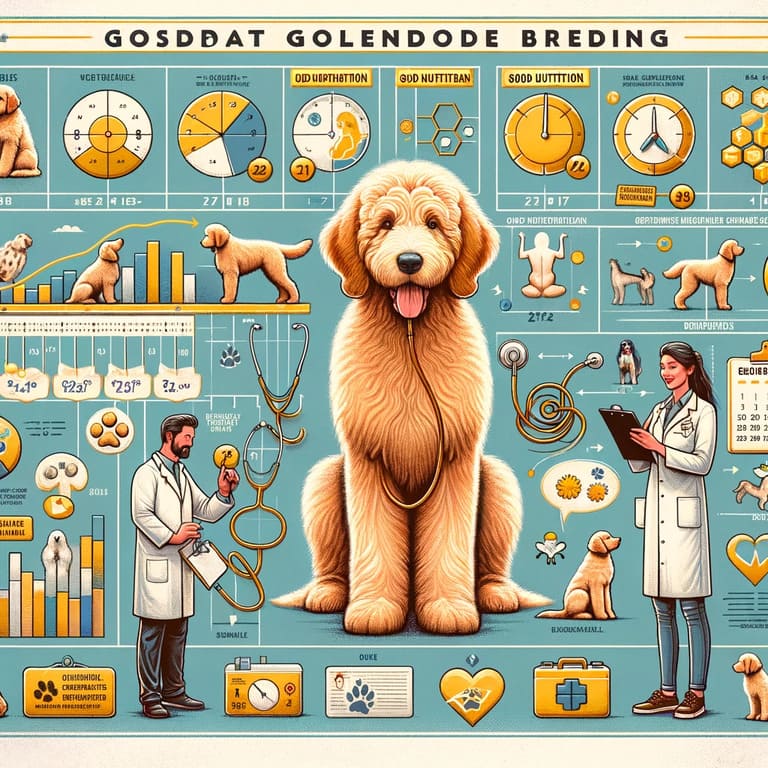
Breeding dogs is an art that requires a deep understanding of their developmental stages and specific breeding considerations. This becomes particularly important for beloved breeds such as Goldendoodles, known for their endearing personalities and hypoallergenic coats.
Key Considerations in Goldendoodle Breeding:
- Understanding Puberty in Goldendoodles:
It’s crucial for owners and breeders to know when these dogs typically reach puberty. This knowledge is foundational for planning a breeding schedule. - Identifying the Right Breeding Age:
Both male and female Goldendoodles have an ideal age range for breeding. Understanding this helps in ensuring healthy breeding practices. - Feasibility of Breeding Two Goldendoodles:
Is breeding two Goldendoodles a good idea? We explore the considerations to keep in mind for such pairings. - Responsible Breeding Frequency:
How often can and should you breed a Goldendoodle? We discuss the importance of responsible breeding intervals for the health of the dog.
This article is designed to provide essential insights and guidance to ensure the health and well-being of Goldendoodles during the breeding process. Whether you are an experienced breeder or a new Goldendoodle owner, this guide will arm you with the necessary knowledge for responsible and ethical breeding practices.
table of content ↑What Age Do Goldendoodles Go Through Puberty?
Goldendoodles, known for their friendly demeanor and hypoallergenic coats, experience puberty like all dogs, but the timing can vary slightly due to their mixed-breed nature. Typically, Goldendoodles start showing signs of puberty between 6 and 9 months of age. However, this can vary depending on their size, with smaller varieties reaching puberty earlier than larger ones.
During this phase, owners might notice physical and behavioral changes. For females, this includes their first heat cycle, characterized by a swollen vulva and possibly a light bloody discharge. Male Goldendoodles may start showing more interest in female dogs and could begin marking their territory more frequently.
It’s important for pet owners to recognize these signs of maturity in their Goldendoodles, as it marks the transition into a phase where reproductive capabilities begin. Understanding this change is crucial, especially if you’re considering breeding or want to prevent accidental pregnancies.
Now, let’s move on to the next section, detailing when male and female Goldendoodles are typically ready to breed.
table of content ↑When Can Male and Female Goldendoodles Breed?
Breeding Goldendoodles should be approached with a sense of responsibility and awareness of the health of the dogs involved. For male Goldendoodles, sexual maturity is typically reached by 6 to 12 months. However, it’s advisable to wait until they are at least one year old before breeding. This delay ensures that they have reached enough physical and mental maturity to handle the breeding process responsibly.
For female Goldendoodles, while they might experience their first heat cycle as early as 6 months, it’s not recommended to breed them during their first cycle. The ideal time to start breeding is after they are at least 18 months old, ensuring they are mature enough both physically and mentally. Breeding females too early can lead to complications both for the mother and the puppies.
It’s also important to consider the health and genetics of both parents before breeding, ensuring that the offspring are healthy and the breeding is ethical.
table of content ↑Can You Breed Two Goldendoodles?
Breeding two Goldendoodles is certainly a possibility and is commonly practiced. Known as “Double Doodles,” these pairings can produce puppies that inherit the desirable traits of both parents, like a gentle temperament and a low-shedding coat. However, there are several important factors to consider before proceeding with such breeding.
Firstly, genetic diversity is crucial. Breeding two Goldendoodles who are closely related can increase the risk of hereditary health issues. Responsible breeders often use genetic testing to ensure the health and well-being of the puppies by avoiding the pairing of dogs with similar genetic weaknesses.
Secondly, it’s essential to consider the physical and temperamental traits of both parent dogs. Goldendoodles can vary significantly in size, coat type, and personality, so selecting two dogs that complement each other can help in producing well-rounded offspring.
Finally, always prioritize the health and welfare of both the parent dogs and the future puppies. This means considering the age, health status, and previous breeding history of both the male and female Goldendoodles.
Responsible breeding practices are key to ensuring the health and happiness of both the parents and their puppies.
table of content ↑How Often Can You Breed A Goldendoodle?
When it comes to breeding Goldendoodles, it’s important to prioritize the health and welfare of the female dog. A common and recommended practice is to breed a female Goldendoodle no more than once a year. This frequency allows her body to fully recover from the previous pregnancy and childbirth, ensuring her long-term health and well-being.
Overbreeding can lead to serious health issues for the female dog, including a higher risk of complications in future pregnancies and a general decline in overall health. It’s also crucial for the well-being of the puppies, as healthier mothers are more likely to produce healthy, well-adjusted puppies.
Moreover, ethical breeding practices involve giving ample time and care to each litter before planning the next one. This includes ensuring that the puppies are healthy, well-socialized, and placed in responsible, loving homes.
In summary, breeding Goldendoodles, or any dog breed, should always be done with consideration for the health of the animals and the quality of care they receive.
table of content ↑References
- Rice, D. (2005). The Complete Book of Dog Breeding. Barron’s Educational Series.
- Jones, A.C., & Smith, K. (2019). Ethical Considerations in Breeding Pedigree Dogs: The Case of the Goldendoodle. Journal of Applied Animal Welfare Science, 22(3), 279-292.
You might be interested in




